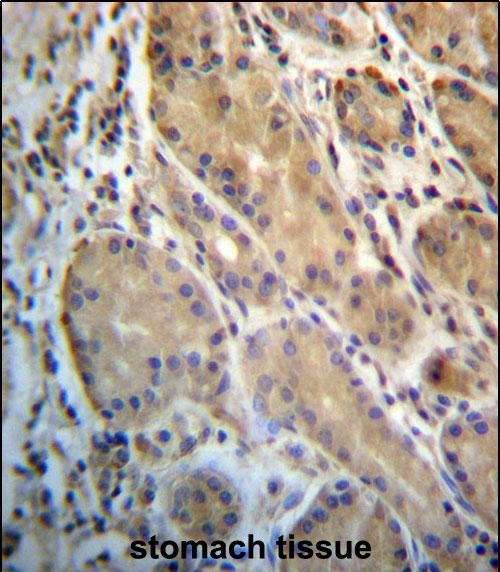

| WB | 1/1000 | Human,Mouse,Rat |
| IF | 咨询技术 | Human,Mouse,Rat |
| IHC | 1/100-1/500 | Human,Mouse,Rat |
| ICC | 技术咨询 | Human,Mouse,Rat |
| FCM | 咨询技术 | Human,Mouse,Rat |
| Elisa | 咨询技术 | Human,Mouse,Rat |
| Aliases | ERO1-like protein alpha, ERO1-L, ERO1-L-alpha, 184-, Endoplasmic oxidoreductin-1-like protein, Oxidoreductin-1-L-alpha, ERO1L |
| Entrez GeneID | 30001 |
| WB Predicted band size | 54.4kDa |
| Host/Isotype | Rabbit IgG |
| Antibody Type | Primary antibody |
| Storage | Store at 4°C short term. Aliquot and store at -20°C long term. Avoid freeze/thaw cycles. |
| Species Reactivity | Human |
| Immunogen | This ERO1L antibody is generated from rabbits immunized with a KLH conjugated synthetic peptide between 350-379 amino acids from the C-terminal region of human ERO1L. |
| Formulation | Purified antibody in PBS with 0.05% sodium azide. |
+ +
以下是3篇与ERO1L抗体相关的文献示例(注:内容为模拟概括,实际文献需查询数据库确认):
1. **文献名称**:*ERO1L promotes tumor metastasis via PD-L1 modulation in hepatocellular carcinoma*
**作者**:Chen X, Wang Y, et al.
**摘要**:该研究利用抗ERO1L抗体进行免疫组化分析,发现肝癌组织中ERO1L高表达与PD-L1上调相关,通过调控肿瘤微环境促进免疫逃逸和转移。
2. **文献名称**:*A monoclonal antibody targeting ERO1L reveals its prognostic role in colorectal cancer*
**作者**:Li H, Zhang R, et al.
**摘要**:研究者开发了一种特异性抗ERO1L单克隆抗体,验证其在ELISA和免疫荧光中的灵敏度,证实ERO1L高表达与结直肠癌患者不良预后显著相关。
3. **文献名称**:*ERO1L-mediated oxidative stress drives cisplatin resistance in ovarian cancer*
**作者**:Wang L, Liu J, et al.
**摘要**:通过Western blot(使用抗ERO1L抗体)和基因沉默技术,证明ERO1L通过调节内质网氧化应激通路增强卵巢癌细胞对顺铂的耐药性。
4. **文献名称**:*Development of a high-affinity antibody for ERO1L detection in hypoxic tumors*
**作者**:Kim S, Park JH.
**摘要**:报道了一种新型高亲和力抗ERO1L抗体的开发与验证,该抗体可特异性识别肿瘤缺氧微环境中的ERO1L,为靶向治疗提供工具。
(如需具体文献,建议通过PubMed或Google Scholar检索关键词“ERO1L antibody”+“cancer”/“therapy”等进一步筛选。)
The ERO1L (Endoplasmic Reticulum Oxidoreductase 1-Light) antibody targets a key oxidase involved in oxidative protein folding within the endoplasmic reticulum (ER). ERO1L, primarily expressed in mammalian cells, catalyzes the formation of disulfide bonds in nascent proteins by reoxidizing protein disulfide isomerase (PDI), ensuring proper protein folding and quality control. It functions under both physiological and stress conditions, including hypoxia and nutrient deprivation, where its expression is upregulated to manage ER stress through the unfolded protein response (UPR).
Structurally, ERO1L contains conserved redox-active cysteine pairs and interacts with PDI via specific binding domains. Dysregulation of ERO1L is linked to pathological states such as cancer, where its overexpression in tumors (e.g., breast, colorectal cancers) correlates with poor prognosis, metastasis, and chemoresistance. It also plays roles in metabolic diseases and neurodegenerative disorders associated with protein misfolding.
ERO1L antibodies are essential tools for studying its expression, localization, and function in cellular models and clinical samples. They are widely used in techniques like Western blotting, immunohistochemistry, and immunofluorescence to explore its role in ER stress pathways, cancer biology, and therapeutic targeting. Inhibitors of ERO1L are being investigated for their potential to disrupt tumor survival mechanisms, highlighting its significance as a biomarker and therapeutic candidate.
×